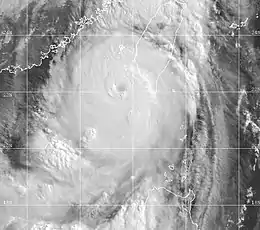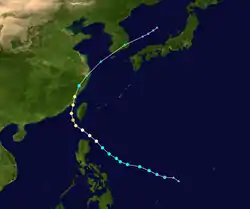Typhoon Chebi (2001)
Typhoon Chebi, known in the Philippines as Typhoon Emong was a typhoon that formed in June 2001.[1]
| Typhoon (JMA scale) | |
|---|---|
| Category 3 typhoon (SSHWS) | |
 | |
| Formed | June 19, 2001 |
| Dissipated | June 24, 2001 |
| Highest winds | 10-minute sustained: 120 km/h (75 mph) 1-minute sustained: 185 km/h (115 mph) |
| Lowest pressure | 965 hPa (mbar); 28.5 inHg |
| Fatalities | 108 total |
| Damage | $471 million (2001 USD) |
| Areas affected | Philippines, China and Taiwan |
| Part of the 2001 Pacific typhoon season | |
Meteorological history

Tropical Depression 04W formed on June 19 near Palau where it moved westward and strengthened into Tropical Storm Chebi six hours later. Chebi then moved generally west-northwest and then to the northwest as the tropical storm passed north of the Philippines on June 21 and entered the Luzon Strait on June 23 as a Category 1 typhoon. Later on the 23rd Chebi reached a peak intensity of 85 knots (160 km/h, 100 mph) as the center of the storm was 75 miles (121 km) south of Taiwan. A trough forced Chebi west and northwest where it made landfall near Fuzhou City, China. Chebi then weakened and accelerated to the north then northeast, passing southeast of Shanghai before exiting back out to sea. The JMA and other weather centers stopped issuing advisories when the remnants of Chebi dissipated in the eastern Pacific on June 30.
Impact
Chebi killed 82 people, mostly in China, and left $422 million (2001 USD), $457 million (2005 USD). Chebi's heavy rains and strong winds left nine people dead, 28 missing and $13 million (2001 USD) in damage in the Philippines. Four of the nine were from a Belizean freighter that sank during the storm.[2] The Penghu Islands, which took the brunt of the typhoon, suffered considerable damage as 102 fishing boats sank and ten thousand people were left without power. The storm also crippled ground and air traffic.[3] A rain laden typhoon, Chebi produced 100 millimeters of rain across Guangdong.[4] About 73 people were killed in China, most of them in the southeastern province of Fujian.[5] The storm also destroyed several thousand acres of crops, resulting in economic losses. In Ningde, about 321,400 houses were destroyed by the typhoon.[6] About 22 people were killed in Hangzhou when a landslide burst through a construction wall.[7]
See also
References
- "Digital Typhoon: Typhoon 200102 (CHEBI) – General Information (Pressure and Track Charts)". agora.ex.nii.ac.jp. Retrieved August 19, 2020.
- "Five Killed, 28 Missing in Taiwan". www.china.org.cn.
- "Typhoon Chebi Brings Rainstorm for Guangdong". en.people.cn.
- "Typhoon Chebi Savages Fujian, At Least 79 Killed". en.people.cn.
- "Pravda.RU China: Typhoon Chebi's toll rises: 22 die in Hangzhou landslide". web.archive.org. September 13, 2001.
